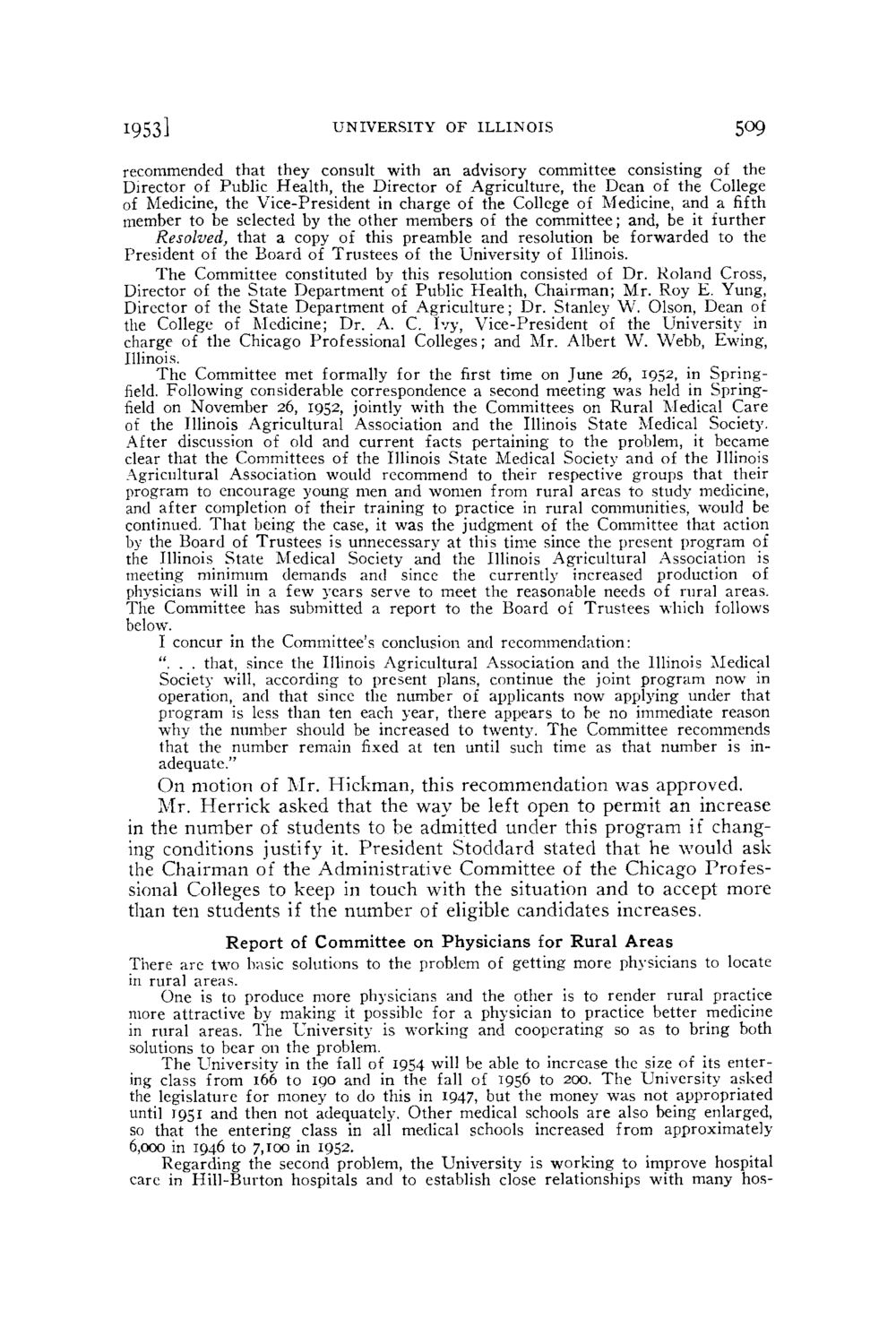| |
| |
Caption: Board of Trustees Minutes - 1954
This is a reduced-resolution page image for fast online browsing.

EXTRACTED TEXT FROM PAGE:
i953l UNIVERSITY OF ILLINOIS 509 recommended that they consult with an advisory committee consisting of the Director of Public Health, the Director of Agriculture, the Dean of the College of Medicine, the Vice-President in charge of the College of Medicine, and a fifth member to be selected by the other members of the committee; and, be it further Resolved, that a copy of this preamble and resolution be forwarded to the President of the Board of Trustees of the University of Illinois. The Committee constituted by this resolution consisted of Dr. Roland Cross, Director of the State Department of Public Health, Chairman; Mr. Roy E. Yung, Director of the State Department of Agriculture; Dr. Stanley W. Olson, Dean of the College of Medicine; Dr. A. C. Ivy, Vice-President of the University in charge of the Chicago Professional Colleges; and Mr. Albert W . Webb, Ewing, Illinois. The Committee met formally for the first time on June 26, 1952, in Springfield. Following considerable correspondence a second meeting was held in Springfield on November 26, 1952, jointly with the Committees on Rural Medical Care of the Illinois Agricultural Association and the Illinois State Medical Society. After discussion of old and current facts pertaining to the problem, it became clear that the Committees of the Illinois State Medical Society and of the Illinois Agricultural Association would recommend to their respective groups that their program to encourage young men and women from rural areas to study medicine, and after completion of their training to practice in rural communities, would be continued. That being the case, it was the judgment of the Committee that action by the Board of Trustees is unnecessary at this time since the present program of the Illinois State Medical Society and the Illinois Agricultural Association is meeting minimum demands and since the currently increased production of physicians will in a few years serve to meet the reasonable needs of rural areas. The Committee has submitted a report to the Board of Trustees which follows below. I concur in the Committee's conclusion and recommendation: ". . . that, since the Illinois Agricultural Association and the Illinois Medical Society will, according to present plans, continue the joint program now in operation, and that since the number of applicants now applying under that program is less than ten each year, there appears to be no immediate reason why the number should be increased to twenty. The Committee recommends that the number remain fixed at ten until such time as that number is inadequate." O n m o t i o n of M r . H i c k m a n , t h i s r e c o m m e n d a t i o n w a s a p p r o v e d . M r . H e r r i c k a s k e d t h a t t h e w a y be left o p e n t o p e r m i t a n i n c r e a s e in t h e n u m b e r of s t u d e n t s to b e a d m i t t e d u n d e r t h i s p r o g r a m if c h a n g ing c o n d i t i o n s j u s t i f y it. P r e s i d e n t S t o d d a r d s t a t e d t h a t h e w o u l d a s k the C h a i r m a n of t h e A d m i n i s t r a t i v e C o m m i t t e e of t h e C h i c a g o P r o f e s sional C o l l e g e s t o k e e p in t o u c h w i t h t h e s i t u a t i o n a n d t o a c c e p t m o r e t h a n t e n s t u d e n t s if t h e n u m b e r of eligible c a n d i d a t e s i n c r e a s e s . Report of Committee on Physicians for Rural Areas There are two basic solutions to the problem of getting more physicians to locate in rural areas. One is to produce more physicians and the other is to render rural practice more attractive by making it possible for a physician to practice better medicine in rural areas. The University is working and cooperating so as to bring both solutions to bear on the problem. The University in the fall of 1954 will be able to increase the size of its entering class from 166 to 190 and in the fall of 1956 to 200. The University asked the legislature for money to do this in 1947, but the money was not appropriated until 1951 and then not adequately. Other medical schools are also being enlarged, so that the entering class in all medical schools increased from approximately 6,000 in 1946 to 7,100 in 1952. Regarding the second problem, the University is working to improve hospital care in Hill-Burton hospitals and to establish close relationships with many hos-
| |